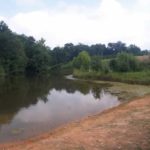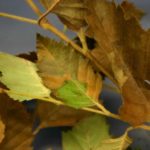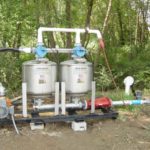Water
go.ncsu.edu/readext?491600
en Español / em Português
El inglés es el idioma de control de esta página. En la medida en que haya algún conflicto entre la traducción al inglés y la traducción, el inglés prevalece.
Al hacer clic en el enlace de traducción se activa un servicio de traducción gratuito para convertir la página al español. Al igual que con cualquier traducción por Internet, la conversión no es sensible al contexto y puede que no traduzca el texto en su significado original. NC State Extension no garantiza la exactitud del texto traducido. Por favor, tenga en cuenta que algunas aplicaciones y/o servicios pueden no funcionar como se espera cuando se traducen.
Português
Inglês é o idioma de controle desta página. Na medida que haja algum conflito entre o texto original em Inglês e a tradução, o Inglês prevalece.
Ao clicar no link de tradução, um serviço gratuito de tradução será ativado para converter a página para o Português. Como em qualquer tradução pela internet, a conversão não é sensivel ao contexto e pode não ocorrer a tradução para o significado orginal. O serviço de Extensão da Carolina do Norte (NC State Extension) não garante a exatidão do texto traduzido. Por favor, observe que algumas funções ou serviços podem não funcionar como esperado após a tradução.
English
English is the controlling language of this page. To the extent there is any conflict between the English text and the translation, English controls.
Clicking on the translation link activates a free translation service to convert the page to Spanish. As with any Internet translation, the conversion is not context-sensitive and may not translate the text to its original meaning. NC State Extension does not guarantee the accuracy of the translated text. Please note that some applications and/or services may not function as expected when translated.
Collapse ▲Water used for irrigation needs to be plentiful year round, clean and free of sediment, and be high quality in terms of nutrients and pathogens present.
- Source Water Quantity
- Source Water Quality
- Irrigation System Design and Management
- Filtration and treatment
- Managing Runoff
Resources
Smart Farms Website SCRI-Minds – Managing Irrigation and Nutrition via Distributed Sensing. A tremendous collaboration of research and extension faculty, regulatory agencies, and other stakeholders focuses on sensing water in the nursery production system and using that information for decision-making.Green Industry Knowledge Center Contains separate training modules for many facets of nursery production and best management practices. It is a must-visit for new county extension agents
Water Education Alliance and Cleanwater3 have teamed up to bring a comprehensive site that contains education, webinars, reading, and references for water used during production of ornamental crops.
Source Water Quantity
Technical Publications
- Fulcher et al. 2016. The Next Ten Years: Strategic Vision of Water Resources for Nursery Producers. HortTechnology. The Next Ten Years: Strategic Vision of Water Resources for Nursery Producers. A collaboration between Amy Fulcher, Anthony V. LeBude, James S. Owen, Jr., Sarah A. White, and Richard C. Beeson to predict water use, quantity, quality, and policy legislation for nursery crops for the next ten years.
- Beeson et al. 2004. Strategic vision of container nursery irrigation in the next ten years. A collaboration between water scientists and growers to predict future water use and define strategies to improve its use efficiency. Beeson, R.C., M.A. Arnold, T.E. Bilderback, B. Bolusky, S. Chandler, H.M. Gramling, J.D. Lea-Cox, J.R. Harris, P.J. Klinger, H.M. Mathers, J.M. Ruter, and T.H. Yeager. J. Environ. Hort. 22(2): 113-1 15. June 2004.
- North Carolina Department of Agriculture and Consumer Services. North Carolina Agriculture Water Use 2014. Great resource to learn data about Ag-specific use of water in North Carolina.
- Maupin et al. 2010. Estimated Use of Water in the United States in 2010. Great information that compares where water is withdrawn from (surface or ground) and from which section of the country. By Molly A. Maupin, Joan F. Kenny, Susan S. Hutson, John K. Lovelace, Nancy L. Barber, and Kristin S. Linsey, 2010, Estimated use of water in the United States in 2010: U.S. Geological Survey Circular 1405, 64 p.
Extension Publications
- Bilderback et al. Water supply and water quality for nursery greenhouse crops.
Good overview of the challenges facing nurseries looking for quality water in large supplies. Bilderback, T., J. Dole, and R. Sneed. NCCES. - Owen and Stoven 2010. Irrigation strategies to conserve water in container nurseries. A great reference to determine irrigation application rate and evaluate irrigation drip and overhead system performance. Irrigation management is also reviewed to assist growers to more efficiently manage irrigation of containerized crops. JS Owen and H Stoven Oregon State University Extension.
General References
- Fulcher et al. 2016. Are we learning from the past? Nursery Management.
Predicts water use, quantity and quality for nursery production in the next 10 years. Published in Nursery Management 2016. Written by Fulcher, Lebude, Owen, White and Beeson. - Myszewski et al. 2005. A comparison of groundwater laws and regulations from southeastern [U.S.] states. Easily grasps the complexity of laws across the southeast US and highlights permitting in some states. Myszewski, M., D.R. Christy, and J.E. Kundell. Carl Vinson Institute of Government U. Georgia (2005).
- NC Drought Bill (2008). Current information about the state of drought in North Carolina, as well as how provisions from the 2008 NC Drought Bill (SL 2008-143) are being implemented by NCDENR’s Division of Water Resources. Go to http://www.ncwater.org/drought/
- NC General Statutes for use of Reclaimed Water. Provides the primary uses and guidelines for RCW use in NC, If legalese is your game, the language in this document will surely keep you interested. Otherwise read some of the other references about reclaimed water use,
 |
Water level low in late summer |
 |
Water level low |
 |
Surface water levels slightly low |
 |
Runoff and retention ponds used for irrigation |
 |
Utilizing natural bodies of water for irrigation |
Source Water Quality
Technical Publications
- 2014 NC Water Quality Assessment for 305(b). Everything you need to know about how the state assesses water quality and where impaired waterways are located. Contains information about the state’s water pollution control program, water quality assessment, and ground water protection program. NC Department of Environment and Natural Resources, Division of Water Quality.
- NCDNR. 2007. Redbook of surface water and wetland standards. A dense thicket of regulations that provides actual maximum values allowed for most pollutants in effluent. Required reading for insomniacs. NC DENR – DIVISION OF WATER QUALITY “REDBOOK” SURFACE WATERS AND WETLANDS STANDARDS NC ADMINISTRATIVE CODE 15A NCAC 02B .0100, .0200 & .0300.
Extension Publications
- Bilderback. Water quality problems and solutions. Dr. Bilderback offers examples of challenges along with their solutions in this annotated power point as pdf.
- Bilderback. Water you thinking? Dr. Bilderback reprises some concepts from his articles and lectures about the main challenges to water quality in nursery production in this annotated power point as pdf. NCCES.
General References
- Bailey et al. Substrate pH and water quality. Provides a greenhouse approach to water quality but covers many relevant concepts about water quality for nursery production in containers. DA Bailey, PV Nelson, and WC Fonteno. NC State University.
- Barlow. 2003. Groundwater in fresh water-salt water environments along the Atlantic seaboard. Learn where there might be saltwater intrusion on the east coast and how that might affect nursery production water quality (nurseries not mentioned specifically). Barlow, Paul M. Ground water in fresh water-salt water environments of the Atlantic Coast (Circular ; 1262) (2003).
 |
Desiccation of foliage on river birch from high salts in irrigation water |
 |
Iron deposits on irrigation heads from water |
 |
Iron deposits on foliage of plants |
Irrigation System Design and Management
Design
- LeBude and Bilderback. 2007. Drip irrigation and fertigation procedures for field grown nursery crops. General guidleines when using drip systems with liquid fertilizer for irrigation. NCCES.
- The handbook of technical irrigation information. Published in 2002, by Hunter Industries, Inc., this handbook contains equations, blueprints, and calculations necessary to design and layout an irrigation system. Use it as reference when diagnosing irrigation problems or designing new field or container systems.
- Bilderback. Irrigating field grown nursery stock. Dr. Bilderback provides an annotated power point printed as a .pdf. It contains valuable insights and examples of irrigating field stock.
Efficiency
- Lea-Cox, J. 2011. Smart irrigation strategies. Dr. John Lea-Cox is a leader in smart irrigation using sensor technology to monitor water availability in containers and field plants. Here Dr. Lea-Cox provides pragmatic solutions to control irrigation by relying on sensing water in the container. Nursery Management online April 2011.
- Yeary, Fulcher, and Leib. 2016. Nursery Irrigation: A guide for reducing risk and improving irrigation. Whitney Yeary, Amy Fulcher, and Brian Leib. 2016. University of Tennessee. PB 1836. Nationally award winning publication contains everything you need to know about source water quality, strategies to use less water while watering, improving plant growth, using fewer inputs, and great success stories of implementation of these concepts in nurseries.
- Warsaw et al. 2010. Water conservation, growth, and water use efficiency of container grown woody ornamentals irrigated based on daily water use. Excellent technical article on using the amount of water plants use daily as the amount of water they receive as irrigation. Most plants were same size as control, yet used less water, so plants were grouped according to water needs. Warsaw, A.L., R.T. Fernandez, B.M. Cregg, and J.A. Andresen. HortScience 44:1308–1318. 2009.
- Owen. 2007. What’s your leaching fraction? A short article about the mechanics of measuring leaching fractions. Owen, J.S. Digger Dec 40-43 (2007).
- Williamson et al. 2004 Timing of overhead irrigation affects growth and substrate temperature of container-grown plants. Study shows that irrigating cyclically during the day, rather than before sunrise increases growth. Authors suggest decreased leaf and substrate temperature during the day from irrigating might be associated with increased growth. CS Williamson, SL Warren, and TE Bilderback. SNA RESEARCH CONFERENCE 49:77-80 (2004).
- Bilderback 2002. Water management is key in reducing nutrient runoff from container nurseries. Excellent overview of many ways to reduce runoff from plant placement, irrigation management, and vegetative buffers. HortTechnology 12:7-9 (2002).
- Bilderback. What is a leaching fraction? Learn the basics of measuring and calculating a leaching fraction with examples provided.
- Bilderback. Cycled irrigation improves irrigation efficiency. Dr. Bilderback talks about cycling irrigation to deliver the entire volume of irrigation in frequent short bursts over the day rather than at one irrigation event. NCCES.
- Bilderback. Container nursery irrigation efficiency, interception efficiency and leaching fraction practices. An annotated power point as pdf, which combines most of Dr. Bilderback’s articles in this section into graphically illustrated examples in the nursery industry. NCCES.
- Warren & Bilderback. 2005. More plant per gallon. A review of research to increase water efficiency by studying water application efficiency, irrigation scheduling, and substrate amendment in nursery production. HortTechnology 15:14-18.
- Bilderback. Calculating irrigation resources and application efficiency. Dr. Bilderback shows how to calculate pond volume and how much water your system is applying per rate of time. NCCES.
- Haman & Yeager. 2001. Field evaluation of container nursery irrigation systems: measuring uniformity of water application of microirrigation systems. Performance of microirrigation systems can be evaluated by measuring operating pressures, application rates, and uniformity of water application under nursery conditions. In this article, a simple test to determine the uniformity of water application is presented. Haman, D. and T.H. Yeager. U. Fl. FS98-1. http://edis.ifas.ufl.edu.
- Evans et al 1997. Field Calibration Procedures for Animal Wastewater Application Equipment: Hard hose cable tow traveler. IRRIGATION SYSTEM. Excellent reference to learn how to calibrate a hose and reel irrigation gun for field application of water. The text deals with waste application, but the theory of calibration is still the same to increase efficiency of irrigation application to field-planted liners. SPOILER ALERT: Contains Math:). R.O. Evans, J.C. Barker, J.T. Smith, R.E. Sheffield, Biological and Agricultural Engineering Extension Specialists, NC State University. 1997. ag 553 2.
- Haman & Yeager. 2001. Field evaluation of container nursery irrigation systems: uniformity of water application in sprinkler systems. A simple method to measure uniform water application, which is necessary to maximize the efficiency of water use in the nursery to save water. Haman, D.Z. and T.H. Yeager. U. Fl. 2FS98-2. http://edis.ifas.ufl.edu.
- Haman & Yeager. 1997. Field evaluation of container nursery irrigation systems Part 2: measuring application rates. Discusses the measurement of application rates for overhead sprinkler systems. Haman, D. and T.H. Yeager. U. Fl. AE-261 (1997).
- Warren and Bilderback 2002. Timing of low pressure irrigation affects plant growth and water utilization efficiency. Early work that shows using three cyclic irrigation volumes to apply the total irrigation volume in the afternoon can lower substrate temperature and increase growth compared to doing the same thing watering before 0700 or 1200. SL Warren and TE Bilderback J. Environ. Hort. 20(3):184–188 (2002).
Resources
- Smart Farms Website. SCRI-Minds – Managing Irrigation and Nutrition via Distributed Sensing. A tremendous collaboration of research and extension faculty, regulatory agencies, and other stakeholders that focuses on sensing water in the nursery production system and using that information for decision making.
- Green Industry Knowledge Center. Contains separate training modules for many facets of nursery production and best management practices. It is a must-visit for new county extension agents
Filtration and Treatment
Technical Publications
- Ufer et al. 2008. Filtration to eliminate Phytophthora spp. from recirculating water systems in commercial nurseries. A practical and visionary idea about installing slow sand filters in nurseries to achieve the volume necessary to irrigate overhead. Ufer, T., Werres, S. K., Posner, M., and Wessels, H.-P. 2008. Filtration to eliminate Phytophthora spp. from recirculating water systems in commercial nurseries. Online. Plant Health Progress doi:10.1094/PHP-2008-0314-01-RS.
Extension Publications
- Zinati, G and Shuai 2005. Management of iron in irrigation water. Comprehensive and nursery focused extension publication from Rutgers about iron in water. Rutgers Cooperative Research & Extension, (NJAES), Rutgers, The State University of New Jersey FS 516.
General References
Managing Runoff
Technical Publications
- Hansen and Ribaudo 2008. Economic measures of soil conservation benefits. USDA. Rather lengthy technical publication that puts values on conservation efforts. Additionally it familiarizes you with the “downstream” factors affected by runoff. Offers a way for agents and growers to put monetary value on conservation efforts within the county. Hansen, LeRoy, and Marc Ribaudo. Economic Measures of Soil Conservation Benefits: Regional Values for Policy Assessment, TB-1922. U.S. Dept. of Agriculture, Econ. Res. Serv. September 2008.
- Reichenberger et al. 2007. Mitigation strategies to reduce pesticide inputs into ground- and surface water and their effectiveness; A review Another review that address the efficacy of vegetated buffer strips and their proper size and placement. Reichenberger, S., M. Bach, A. Skitschak, H-G. Frede. Science of the Total Environment 384 (2007) 1–35.
Extension Publications
- Haver 2004. Sediment management goals and management practices for nursery and floriculture. Nursery specific BMP’s from California where guidelines for runoff and sediment load are more stringent than in the east. Haver, D. 2004. UCDavis Division Agriculture and Natural Resources.
- Riparian buffer fact sheet for Catawba river (2012) Just a quick infographic to show vegetated buffer strips (VBS) Riparian buffer strips (RBS) or filter strips (FS) used to comply with riparian buffer regulation along the Catawba river watershed.
General References
- Oki and White 2012 Constructed Wetlands. Learn how to remediate pesticides from recycled water and runoff. Two leaders in constructed wetlands highlight the benefits of using the concept on nurseries. NurseryManagementonline.com. 2012. pp. 24-28.
- Bracmort et al. 2004. Estimating the long-term benefits and costs of BMPs in an agricultural watershed. A cost-benefit analysis was performed on a large watershed management project that installed hundreds of BMPs in the mid-1970s. Water quality improvement for sediment and total phosphorus reduction due to BMP implementation was estimated using off-site benefit estimates, fertilizer nutrient costs and water quality trading values. A great practical paper to introduce cost benefit analysis for BMPs. This is a critical issue in the water management. Bracmort, KS, JG Lee , BA Engel, JR Frankenberger. Paper No: 042174 An ASAE Meeting Presentation.
- Doll et al. Stream restoration: a natural channel design handbook. Excellent reference on the topic for North Carolina. Provides great review of practices, pictures, efficacy data, and examples.
- Streambank Soil Bioengineering. Another excellent reference about plant material, decreasing erosion, and stabilizing stream banks. Combined with the stream restoration reference, these references provide a great primer on the subject. Excerpt from the national engineering handbook. Chapter 11 Tech Supp 141.



























